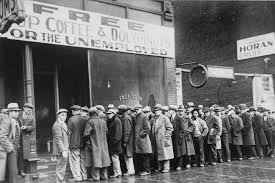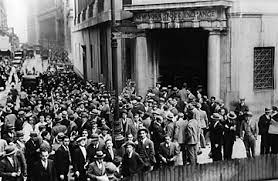The Causes of the Crash: A Perfect Storm
The 1920s, known as the “Roaring Twenties,” were a period of unprecedented economic prosperity and technological advancement. A sense of optimism and a belief in endless growth fueled a speculative boom, especially in the stock market. However, a series of underlying issues created a fragile economic foundation that was ripe for collapse.
A. Widespread Speculation and Margin Buying: The most significant factor contributing to the crash was the rampant speculation that gripped the nation. Everyone, from seasoned investors to ordinary citizens, was pouring money into the stock market. A popular practice at the time was buying on margin, where an investor could buy stock by paying only a small percentage of the price (as little as 10%) and borrowing the rest from a broker. This practice amplified gains when the market was rising but also magnified losses when prices fell. When the market started to decline, brokers issued “margin calls,” demanding investors repay their loans. This forced a wave of panicked selling, which only accelerated the market’s freefall.
B. The Overheated Economy and Corporate Profits: The Roaring Twenties saw a boom in industrial production and corporate profits. However, much of this growth was built on shaky ground. Production was outpacing consumer demand, leading to an excess of goods in warehouses. Corporations used their inflated profits not to raise wages or reinvest in their businesses, but to lend money to speculators in the stock market. This created a dangerous feedback loop where corporate profits were artificially boosted by market speculation, not genuine economic growth.
C. Lack of Financial Regulation and Oversight: The financial markets of the 1920s were largely unregulated. There were no rules to prevent insider trading, price manipulation, or the kind of fraudulent behavior that was common at the time. The government’s laissez-faire approach allowed a sense of unbridled confidence to take hold. There was no Securities and Exchange Commission (SEC) to monitor markets, and banks were not subject to the strict regulations we see today. This lack of a financial safety net meant that when the market began to collapse, there was nothing to stop the domino effect.
The Market’s Fall: Black Thursday and Black Tuesday
The crash began on Thursday, October 24, 1929, known as “Black Thursday.” A sudden surge of selling caused stock prices to plummet. While a group of leading bankers attempted to stabilize the market by buying up shares, their efforts were a temporary fix. The worst was yet to come. The panic intensified on “Black Monday,” October 28, and culminated on “Black Tuesday,” October 29, 1929, when a record number of shares were traded, and the market suffered its single largest drop in history. Over the next month, the market would continue to decline, wiping out billions of dollars in wealth and marking the end of the speculative boom.

The Aftermath and Lasting Lessons
The 1929 crash was a direct cause of the Great Depression, a decade-long period of mass unemployment, poverty, and economic stagnation. It taught a series of hard-won lessons that have shaped the global financial system ever since.
A. The Need for Regulatory Bodies: The most significant lesson was the absolute necessity of government regulation to protect investors and ensure market stability. The crash led directly to the creation of the Securities and Exchange Commission (SEC) in 1934, with the mission to regulate the securities industry and enforce federal securities laws. The Glass-Steagall Act was also passed, separating commercial and investment banking to prevent banks from taking on excessive risks with their depositors’ money. These institutions and laws were designed to prevent a similar collapse by ensuring transparency and accountability.
B. The Perils of Excessive Leverage: The practice of buying on margin was a key driver of the crash’s severity. It showed that excessive leverage can turn a market correction into a financial catastrophe. Today, regulations on margin requirements are far stricter, and investors are required to have a much higher percentage of cash to trade on leverage. This limits the risk of a widespread chain reaction of forced selling.
C. The Importance of Diversification: Many investors in the 1920s had all their money concentrated in a few popular stocks, a risky strategy that made them vulnerable to the crash. The event taught a painful lesson about the importance of portfolio diversification, the strategy of spreading investments across a wide range of assets to mitigate risk. This principle is now a cornerstone of modern financial planning and investment advice.
D. The Role of Central Banks and Monetary Policy: The Federal Reserve’s response to the crisis was widely criticized for being too slow and contractionary. Instead of injecting money into the economy to stabilize the financial system, they tightened monetary policy, exacerbating the depression. This led to a fundamental shift in the role of central banks, which now act as a “lender of last resort” during financial crises to provide liquidity and prevent systemic collapse, a role we saw in action during the 2008 financial crisis.
E. The Link Between Investor Psychology and Market Behavior: The crash was a masterclass in behavioral economics. It showed how a shift in investor sentiment—from unbridled optimism to mass panic—can have a greater impact on market movements than fundamental economic data. This understanding of human psychology in markets is now a key area of study, with concepts like herd behavior and market exuberance being central to our understanding of how financial bubbles form and burst.
Conclusion: An Echo in Modern Crises
The lessons from 1929 are not just historical footnotes; they are a blueprint for understanding modern financial crises. The 2008 financial crisis, for instance, shared striking similarities, including a speculative bubble (in real estate), widespread use of leverage (through subprime mortgages and derivatives), and a failure of regulatory oversight. The global response to 2008, with coordinated central bank action and a renewed focus on systemic risk, was a direct application of the lessons learned from 1929.
Today, as new technologies and financial instruments emerge, the core lessons remain constant. The dangers of excessive leverage, the importance of diversification, the power of human psychology, and the absolute necessity of robust financial regulation are timeless truths. The Wall Street Crash of 1929 serves as a permanent, stark reminder that without a disciplined, well-regulated, and cautious approach, the seeds of prosperity can easily give way to the weeds of ruin.












